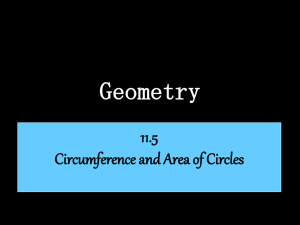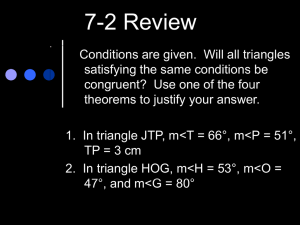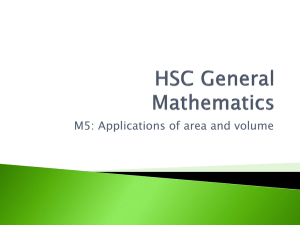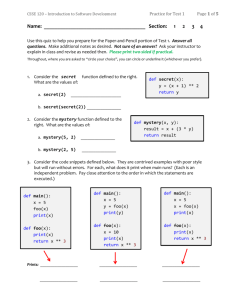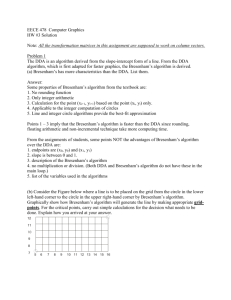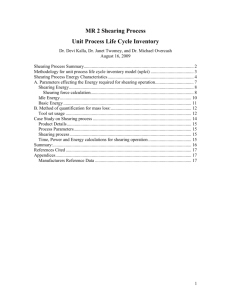Chapter 12: Area of Shapes
advertisement
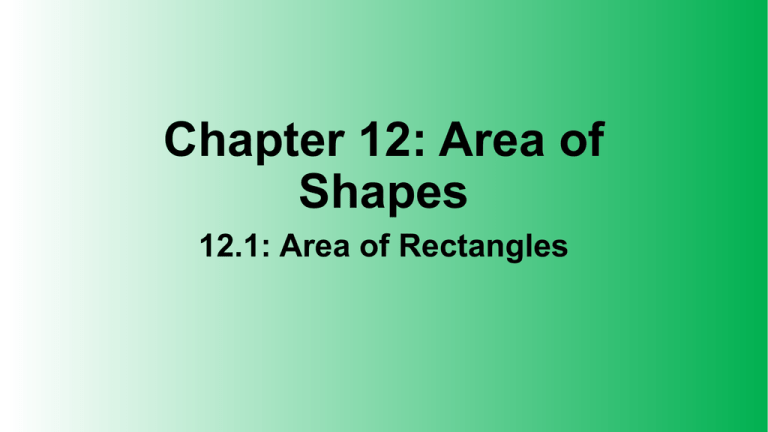
Chapter 12: Area of Shapes 12.1: Area of Rectangles Area of Rectangles •The Area of an L-unit by W-unit rectangle is • Area = L x W •True for any non-negative values L and W Section 12.2: Moving and Additive Principles About Area The Moving and Additive Principles • Moving Principle: If you move a shape rigidly without stretching it, then its area does not change. • Rigid motions include translations, reflections, and rotations • Additive Principle: If you combine a finite number of shapes without overlapping them, then the area of the resulting shape is the sum of the areas of the individual shapes. Example Problems • Ex 1: Determine the area of the following shape. Ex 1: • Ex 2: Determine the • area of the following • shape. • Ex 3: The UK Math Department is going to retile hallway of the 7th floor of POT, shown below. How many square feet is the hallway? See Activity 12 C, problem 1 • Ex 4: Determine the area of the following hexagon. Section 12.3: Area of Triangles Example Problem • Ex 1: Determine the area of the following triangle. 12 Triangle Definitions • Def: The base of a triangle is any of its three sides • Def: Once the base is selected, the height is the line segment that • is perpendicular to the base & • connects the base or an extension of it to the opposite vertex 13 Base and Height Ex’s 14 Area of a Triangle • The area of a triangle with base b and height h is given by the formula 1 𝐴𝑟𝑒𝑎 = ∙ 𝑏 ∙ ℎ 2 • It doesn’t matter which side you choose as the base! 15 Revisiting Example 1 • Ex 1: Determine the area of the following triangle. 16 • See problems in Activities 12F and 12G 17 Section 12.4: Area of Parallelograms and Other Polygons • See Activity 12H 19 Definitions for Parallelograms • Def: The base of a parallelogram is any of its four sides • Def: Once the base is selected, the height of a parallelogram is a line segment that • perpendicular to the base & • connects the base or an extension of it to a vertex on not on the base 20 Area of a Parallelogram • The area of a parallelogram with base b and height h is 𝐴𝑟𝑒𝑎 = 𝑏 ∙ ℎ 21 Section 12.5: Shearing What is shearing? Def: The process of shearing a polygon: • Pick a side as its base • Slice the polygon into infinitesimally thin strips that are parallel to the base • Slide strips so that they all remain parallel to and stay the same distance from the base 23 Examples of Shearing 24 Result of Shearing • Cavalieri’s Principle: The original and sheared shapes have the same area. Key observations during the shearing process: • Each point moves along a line parallel to the base • The strips remain the same length • The height of the stacked strips remains the same 25 Section 12.6: Area of Circles and the Number π Definitions • Def: The circumference of a circle is the distance around a circle • Recall: radius- the distance from the center to any point on the circle diameter- the distance across the circle through the center 𝐷 = 2𝑟 27 The number π • Def: The number pi, or π, is the ratio of the circumference and diameter of any circle. That is, 𝐶 𝜋= 𝐷 • Circumference Formulas: The circumference of a circle is given by 𝐶 = π∙D or 𝐶 = 2πr 28 Quick Example Problem • Ex 1: A circular racetrack with a radius of 4 miles has what length for each lap? 29 How to demonstrate the size of π • See activities 12M and 12N 30 Area of a Circle • The area of a circle with radius 𝑟 is given by 𝐴 = π∙𝑟 2 • See Activity 12O to see why 31 Example Problems • Ex 2: If you make a 5 foot wide path around a circular courtyard that has a 15 foot radius, what is the area of the new path? • Ex 3: A 1 4 mile running track has the following shape consisting of a rectangle with 2 semicircles on the ends. If you are planting sod inside the track, how many square feet of sod do you need? 32 Section 12.7: Approximating Areas of Irregular Shapes How do we estimate the area of the following shape? 34 Methods for Estimating Area • Graph Paper: 1. Draw/trace shape onto graph paper 2. Count the approximate number of squares inside the shape 3. Convert the number of squares into a standard unit of area based on the size of each square • Modeling Dough: 1. Cover the shape with a layer (of uniform thickness) of modeling dough 2. Reform the dough into a regular shape such as a rectangle or circle (of the same thickness) 3. Calculate the area of the regular shape • Card Stock: 1. Draw/trace shape onto card stock 2. Cut out the shape and measure its weight 3. Weigh a single sheet of card stock 4. Use ratios of the weights and the area of one sheet to estimate the shape’s area 35 See Example problems in Activity 12Q 36



